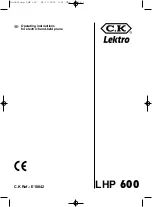
11
OPERATING INSTRUCTIONS
7. Planing
WARNING
• Always wear ANSI-approved safety goggles and
a NIOSH-approved dust mask or respirator along
with heavy-duty work gloves when operating this
tool.
• Make sure that the trigger switch (A) is released
and the battery is removed before making any
adjustments to planer or planer attachments.
• Hold the tool with both hands while starting the
tool, since torque from the motor can cause the
tool to twist.
a.
Support the workpiece using bench-mounted
clamps, a vise, or another safe, practical support.
b.
Adjust the edge guide (P) (if required) and the cutting depth as appropriate.
c.
While standing comfortably, hold the planer firmly with both hands.
d.
Turn the planer on with the trigger switch (A) and wait until it runs at full speed before
placing it on the workpiece.
e.
Place the front plate flat (F) on the workpiece and push the planer forward at an even
speed.
f.
Move the planer gently forward, applying pressure on the front of the planer at the
beginning of the planing pass and pressure at the rear of the planer at the end of the
planing pass.
g.
When finished planing, carefully lift the planer from the workpiece and release the trigger
switch. Wait until the planer blade comes to a complete stop.
h.
Remove the battery and turn the depth-adjustment knob (C) to the P (park) setting. Store
in a safe, clean, dry location.
NOTICE:
Reduce feed rate for the cut and/or reduce the depth of the cut, if the motor begins
to stall.
NOTICE:
Practice first on a scrap piece of material to gauge the correct feed rate and the
cutting depths.
7












































